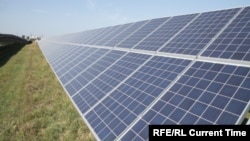Enough power to light and heat not only Central Asia's big cities and towns but also remote villages, and at less cost than current energy sources. That was the topic of discussion at the Central Asia Regional Economic Cooperation's (CAREC) 3rd Energy Investment Forum (EIF) in Batumi, Georgia, on September 11-12.
CAREC is a project of the Asian Development Bank, seeking to promote "regional cooperation in four priority areas: transport; trade facilitation; energy, and trade policy."
Government officials and corporate representatives presented their ideas for bringing CAREC countries -- Afghanistan, Azerbaijan, China, Georgia, Kazakhstan, Kyrgyzstan, Mongolia, Pakistan, Tajikistan, Turkmenistan, and Uzbekistan -- firmly into the 21st century in terms of alternative, green sources of energy.
As speakers made clear, it is not simply an ecological matter. In many of the CAREC countries, certainly in Central Asia, the decades-old power plants currently in use that consume coal, gas, or oil will soon need to be replaced, and the estimated cost of new hydrocarbon-based facilities is actually higher than that of plants that would use geothermal, solar, wind, or hydropower.
Fossil-fuel-based power plants are also regarded as less efficient. Power-transmission lines sometimes need to stretch hundreds of kilometers to reach smaller communities. Those lines lose electricity along their routes. Even with technological improvements, up to 10 percent of power can simply dissipate as it travels far from power stations.
Green sources of energy can be better targeted to meet the power needs of small towns and villages that are hundreds of kilometers from major cities where large power plants are usually located. Solar power plants and wind farms can be constructed near inhabited areas of the hinterland and supply sufficient energy to not only provide light and heat but also to open up new industries: small factories and shops that could provide new employment for local populations.
Solar might arguably be the power source of choice. "Human civilization has spent too much time looking down while the sun is burning our back," Sohail Hasnie of the ADB said during the conference. A solar panel that generates 100 watts of electricity cost, on average, some $37 in 2016; but by the end of the year, that cost is expected to have decreased to around $24, and it is expected to continue to fall.
Central Asia is ideally located to take advantage of solar power. Countries there average some 250 sunny days a year. Marina Asankulova of the Kyrgyz Transport Ministry said her country was looking into ways to harness solar and wind power, even as Kyrgyzstan progresses on hydropower projects.
It was noted that hydro- and solar power can actually go hand in hand. One presentation suggested that China is helping to pioneer such a combination of green energy sources with a floating solar farm in the Three Gorges area, ironically at the site of a former coal mine that collapsed and filled with water. Chinese authorities say the $151 million floating solar plant can deliver some 150 megawatts of electricity, enough to supply power to around 50,000 homes.
Tajikistan is due to launch the first turbine at its Roghun hydropower plant in November. Eventually there should be six units at Roghun, generating 3,600 megawatts of electricity; but the surface area of the reservoir is some 110 square kilometers, ideal for construction of a floating solar farm.
Of course, hydropower plants run at peak capacity in the warming months when snows melt; and not every day is sunny or windy. So the EIF in Batumi also featured presentations on developments with battery storage, the so-called super lithium-ion batteries Tesla chief Elon Musk has been working on. Here, too, efficiency is improving and costs are decreasing as companies work to store excess solar and wind power.
...But There's A Catch
Allow me to digress here for a moment, because I have seen some of this technology work on very small scales in Central Asia. I remember a lonely house in the hills outside of Tash-Kumyr, in Kyrgyzstan, that was receiving power from a small windmill. In a remote area of Kyrgyzstan's southern Batken Province I saw a house powered by a "microhydro" source -- a paddle wheel about the size of a car tire placed in an "aryk," or small canal, that passed by the family home. And, of course, there is the yurt of the future that I wrote about years ago.
These sources of power appear cheaper and cleaner, and one or another of them can be set up practically anywhere. Seems an obvious choice.
But there is an obstacle, and it's a formidable one: the fossil-fuel industry. As I mentioned in a previous article, coal use is actually increasing in Central Asia.
In Central Asia, the people in charge of the oil, gas, and coal industries, and power plants, tend to be people close to government officials, or even government officials themselves. Any conversion to greener, more affordable sources of energy could threaten their personal fortunes. Solar and wind farms can be connected to major power grids, but solar and wind (and microhydro) work off the grid, too, translating into little or no profit for state or big power companies.







